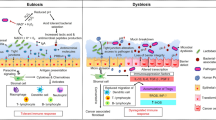Abstract
The relation between expression of several splicing variants of the CD 44 glycoprotein by tumor cells and the increased risk of metastases was discussed recently. By means of an immunocytochemical study (imprint cytology specimens from 94 invasive cervical carcinomas) we have shown a significant correlation between expression of CD 44 v6 and invasion of lymphatic vessels, lymphangiosis carcinomatosa in the primary tumor and the total number of positive pelvic lymph nodes. Expression of CD 44 v6 was not correlated with staging, grading and histological type. CD 44 v6 could therefore be considered as a predictor of lymphatic metastases in cervical carcinoma.
Similar content being viewed by others
References
Arch A, Wirth K, Hofmann M, Ponta H, Matzku S, Herrlich P, Zöller M (1992) Participation in normal immune response of a metastasis-inducing splice variant of CD 44. Science 257:682–685
Aruffo A, Stamencovic I, Melnick M, Underhill CB, Seed B (1990) CD 44 is the principal cell surface receptor for hyaluronate. Cell 61:1303–1313
Dall P, Heider K-H, Hekele A, von Minckwitz G, Kaufmann M, Ponta H, Herrlich P (1994) Surface protein expression and messenger RNA-splicing analysis of CD 44 in uterine cervical cancer and normal cervical epithelium. Cancer Res 54:3337–3341
Denning SM, Le PT, Singer KH, Haynes BF (1990) Antibodies against the CD 44 p80 lymphocyte homing receptor molecule augment human peripheral blood T cell activation. J Immunol 144:7–15
Fox B, Gatter KC, Jackson B, Screaton GR, Bell MV Bell J, Harris I, Simmons D, Fawcett J (1993) CD 44 and cancer screening. Lancet 342:548–549
Hekele A, Dall P, Ponta H, Herrlich P (1994) Die diagnostische und therapeutische Bedeutung von CD 44 beim Zervixkarzinom — Erzeugung Epitop-spezifischer T-Zellen. Arch Gynecol Obstet [Suppl 1] 255:181
Herrlich P, Zöller M, Pals ST, Ponta H (1993) CD 44 splice variants: metastases meet lymphocytes. Immunol Today 14:395–399
Herrlich P, Rudy W, Hofmann M, Arch R, Zöller M, Zawadzki V, Tölg C, Hekele A, Pals S, Heider K-H, Sleemann J, Ponta H (1994) CD 4 and splice variants of CD 44 in normal differentiation and tumor progression. In: Cell adhesion molecules. Livingston DM et al. (eds), Edigraf, Rome (in press)
Huet S, Groux H, Caillou B, Valentin H, Prieur AM, Bernard A (1989) CD 44 contributes to T cell activation. J Immunol 143:798–801
Jalkanen ST, Bargatze RF, Herron LR, Butcher EC (1986) A lymphoid cell surface glycoprotein involved in endothelial cell recognotion and lymphocyte homing in man. Eur J Immunol 16:1195–1202
Jalkanen S, Jalkanen M (1992) Lymphocyte CD 44 binds the COOH-terminal heparin-binding domain of fibronectin. J Cell Biol 116:817–825
Kim H, Yang X-L, Rosada C, Hamilton SR, August JT (1994) CD 44 expression in colorectal adenomas is an early event occuring prior to K-ras and p53 gene mutation. Arch Biochem Biophys 310:504–507
Koopmann G, Heider KH, Horst E (1993) Activated human lymphocytes and aggressive nonHodgkins lymphomas express a homologue of the rat metastasis-associated variant of CD 44. J Exp Med 177:897–904
Matsumara Y, Tarin D (1992) Significance of CD 44 gene products for cancer diagnosis and disease evaluation. Lancet 349:1053–1058
McGee-Russel SM (1958) Histochemical methods for calcium. J Histochem Cytochem 6:22–42
Norusis MJ (1990) SPSS/PC + Advanced statistics 4,0 for the IBM PC/XT/AT and PS/2. In: SPSS Inc (Eds.) Chicago
Screaton GR, Bell MV Jackson DG, Cornelis FB, Gerth U, Bell JI (1992) Genomic structure of DNA encoding the lymphocyte homing receptor CD 44 leveals at least 12 alternatively spliced axons. Proc Natl Acad Sci 89:12160–12164
Sternberger LA (1986) Immunocytochemistry, 3rd ed. J Wiley & Son. New York, Chichester, Brisbane, Toronto
Tanabe KK, Ellis LM, Says H (1993) Expression of CD 44 adhesion molecule in colon carcinomas and metastases. Lancet 341:725–726
Terpe H-J, Stark H, Prehm P, Günthert U (1994) CD 44 variant isoforms are preferentially expressed in basal epithelium of non-malignant human fetal and adult tissues. Histochemistry 101:79–89
UICC (1993) TNM-Atlas. Illustrierter Leitfaden zur TNM/pTNM-Klassifikation maligner Tumoren 3. Aufl. Springer, Berlin Heidelberg New York
Underhill C (1992) The hyaluronan receptor. J Cell Science 103:293–298
Zöller M, Kaufmann M (1994) CD 44 and Metastasis. Onkologie 17:114–122
Author information
Authors and Affiliations
Additional information
Correspondence to: U. Köhler
Rights and permissions
About this article
Cite this article
Biesold, C., Köhler, U., Horn, LC. et al. CD 44 exon v6 as a predictor of lymphatic metastases in cervical carcinoma — an immunocytochemical study of 94 cases. Arch Gynecol Obstet 256, 147–153 (1995). https://doi.org/10.1007/BF01314643
Received:
Accepted:
Issue Date:
DOI: https://doi.org/10.1007/BF01314643




